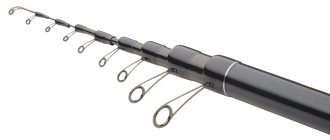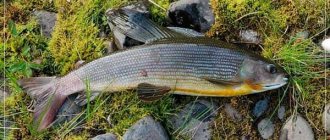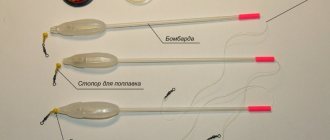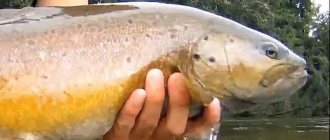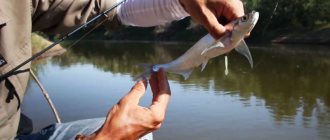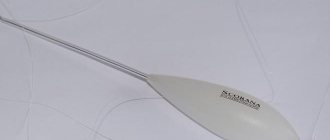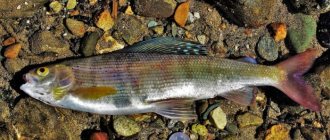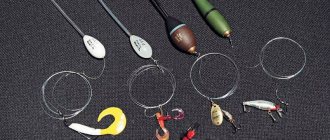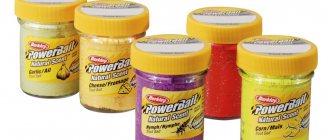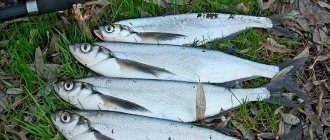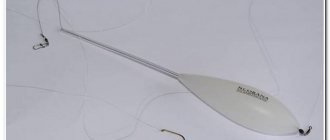Not every angler with extensive experience can boast to his friends about his catch of real grayling. This fish is rare and lives in some freshwater bodies. Its lifestyle is not yet known to everyone, but the secret of effective fishing has long been revealed by Italian fishermen. Bombarda or sbirulino is their invention, which has taken root in our area under the name balamboshka, more often it is called balda. In this article we will talk about the characteristics of the aquatic inhabitant, the gear and its advantages, the method of preparing and using the bait, bait, and also give valuable tips and recommendations.
The use of a bombard is most effective in warm weather, when grayling feeds in the upper layers of the river.
Resident of Siberian waters
Grayling is a representative of the salmon family; these fish are popularly called “red”. Lives mainly in clean, cold water bodies of Siberia with strong currents. His powerful physique speaks of this lifestyle. This is a large, streamlined fish with strong scales and a large dorsal fin decorated with variegated spots.
A fast current can smash your body against any obstacle. Graylings are so powerful and strong that no blows can harm them. Large fins allow these inhabitants to easily navigate among the rocks of fast Siberian rivers.
Fishermen sometimes call grayling "red legend".
The species has only one main enemy that does not allow it to live, eat and reproduce - source pollution. As for changes in climatic conditions, the survival rate of grayling does not deteriorate.
There is a very strong misconception about the nutrition of grayling. Many people think that it collects food exclusively from the surface of the water. Not really. Grayling prefers to look for food in the water column or from the bottom (less often). This is why experienced fishermen prefer to use a bombard.
Overseas float
An Italian development called sbirulino has become a traditional tackle for catching the “red legend”. It is a weighted float for long casts, resembling an elongated egg or a small projectile. The immersed end is less elongated and contains a small load inside.
The bulldozer is made only from light materials, otherwise it will turn out to be a donka.
The balamboshka consists of a body, a coupler and a load. Its design is very simple, here is an example of a classic bombard design:
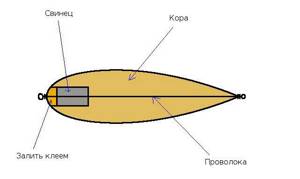
The device of the Siberian bulldozer
Siberian fishermen made the base from wood or willow bark (it floats well), and the Italians preferred to use cork to make sbirulino. Nowadays, specimens made of special compacted foam are becoming increasingly common. The “fishing weight” – lead – is used as cargo. One end of the beam is drilled, a small roll of this metal is placed there, fixing it with glue. The tie acts as the axis of the tackle and at the same time serves as a fastening for the fishing lines. Before installing it, the bombard is drilled through, from end to end. The protruding parts of the wire are bent, making loops of two or three turns.
Only durable stainless metal is suitable as a connector. As a result of corrosion, the tie can come apart, which often leads to the loss of bait, or, even worse, fish.
Equipment Features
There are two options for rigging a bombard for grayling: traditional and “Siberian”. The first involves attaching leashes after the bulldozer to the end where the load is located. In the second case, the angler first attaches the flies, and only then the float.
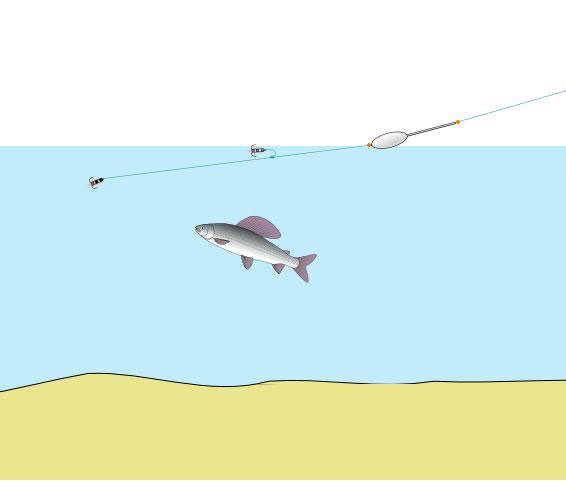
Grayling attack on flies tied to a European bombard
There is a debate among fishermen about the optimal option. What kind of equipment is better? Both traditional and methods invented by Siberian fishermen have their disadvantages and advantages. The fisherman himself decides about the effectiveness.
Classic equipment:
- in the absence of skills, snags and overlaps can often occur;
- the bait line can be thinner than the main line, which increases the catchability of the gear;
- It is possible to deepen the bait if necessary.
"Siberian" method:
- easy to use even for a beginner: there can be no overlaps, snags or other troubles;
- the thickness of both lines is the same and is selected in accordance with the weight of the loaded float;
- accuracy decreases, but casting range increases;
- Often it is necessary to use locking units and swivels. This is due to the inability to deepen the bait - in this version, the bulldozer will keep it on the surface.
The length of the equipment tied after the rod is limited by the length of the rod. During casting, the very last fly should not touch the ground to avoid snagging. It is better to use long fishing rods.
Sbirulino rig for catching rudd
Sbirulino floats come in a variety of sizes and weights, but it is best to buy floats whose weight will fluctuate around forty grams.
Types and types
By type, these floats are:
- floating;
- slowly sinking;
- sinking quickly.
They are used for catching fish at different water levels in reservoirs.
For example, trout fish are usually found on the surface of the water, so floating bombards should be used to catch them, and pike perch most often live on the bottom, so it would be wise to use a fast-sinking float to catch them.
Based on the position of the built-in weight in bombards, the following varieties are distinguished:
- Classiche. This is a float that is considered a classic. The weight in it is located in the lower region of the “body” of the tackle. Due to this arrangement of the weight, this bombard enters the water along a vertical line;
- Moretto. The weight in this float is located throughout its “body”. It is used for fishing in mid-water levels or on the bottom. Due to the fact that the weight of the weight is evenly distributed along the entire length of the float, it always enters the water very smoothly and behaves smoothly when moving;
- Competition The weight in this float is located in its very center, so the bombard has a parallel position in relation to the fishing line during retrieving and entering the water, which makes it very sensitive to bite. In addition, by moving the fishing rod and retrieving movements, you can add additional speed to the bait, causing the bombard to oscillate near it;
- Match. The weight in these floats has an elongated shape and is located in the upper zone of the float. When wiring, their position is very close horizontally. Such a bombard is usually immersed in water with its upper part and immediately sinks to the bottom;
- Magic. The weight is located in different parts of the float - upper and lower. This is the most sensitive bombard. When entering the water, it has a horizontal position.
Leash
The length and material of the leash are selected depending on the desired catch. Despite this, there is a classic version of the leash, which is made from a fluorocarbonate piece of fishing line with a diameter of 0.20 mm and a length of 1.5 meters.
Swivel
Swivels are used to equip bombards so that the fishing line that holds them does not get tangled or twisted, since spinners often tangle it.
It is best to use a triple swivel for a bombard, the size of which will be from fifteen to twenty.
Hooks
Hooks should be as strong as possible and have very sharp tips. If the catch will be made with live bait, then the hook should have a long shank and a small “beard”.
The size of hooks should be selected depending on what kind of fish will be caught and what its average size is.
This equipment includes the following elements:
- swivel clasps;
- a leash with a length of two to three meters, which can be made of monofilament or florocarbon fishing line;
- bombard float;
- bait.
Such equipment can have two different installations:
- Thread the main line into the bombard. After this, you should fasten the bead, which will act as a stopper. At the tip of the main fishing line, tie three swivels and a leash with a length of two and a half meters.
- Attach bait to the tip of the leash. Attach swivels to the main line and tie a leash with a length of one and a half to three meters. Attach a bombard to the tip of the leash.
Tying the bait
Anglers usually use simple figure-of-eight knots. They recommend that beginners start with one fly and gradually acquire the skills of catching grayling with a bombard. If the river is narrow, then there is no need to tie a few more pieces - it will spoil the whole mood.
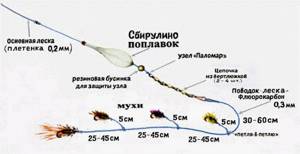
Bolamboshka with four flies and a chain of swivels
In the traditional version, the first fly should always be at the very end of the bait line, and those behind it should be on leads. The second method involves only a leash attachment. The equipment is carried out like this, the main thing is not to confuse it:
- The bait line is folded together with the leash.
- A single figure-eight knot is made from them.
- The end directed towards the bulldozer is connected to the fly.
- The one that heads towards the final bait is bitten off and melted.
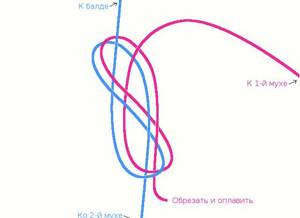
"Eight" of two lines
The knots are reliable, self-tightening - nothing will come off.
There should be a distance of at least one meter between the first fly and the boom!
The advantages of fishing
Bombarda fishing is ideal for both beginners and professionals. The main advantages of a bombard for fishing:
- This tackle allows you to make long casts.
- With a bombard you can cast even ultra-light baits, for example, a fly.
- You can catch almost all types of fish with this bombard tackle.
- It is much easier to catch a large specimen from the shore than from a boat.
- Fishing at different depths.
- It becomes possible to fish in hard-to-reach places.
This versatile fishing float can yield big catches, so everyone should try this bombard fishing method.
Choosing a fishing line
There are no special requirements for it: braided fishing line, multifilament or simple monofilament will do. It all depends on the method of rigging and the weight of the bulldozer.
From reel to sbirulino
Thin lines are suitable for “European” grayling fishing with a bombard, because imported purchased floats weigh from 15 to 20 grams. You can wind a braided line of 0.1 millimeters, or a simple fishing line of 0.23.
If we talk about the balda (100 - 150 grams), which is used by Siberian fishermen, then a thicker fishing line is needed. Monofilament - 0.5 mm, or 0.25 - braided.
The braided type of fishing line increases the sensitivity of the entire tackle to bite.
Thickness
Fishermen advise using 0.2 mm - such a fishing line can withstand the resistance of even a kilogram grayling. You can take 0.3 as a reserve if you are afraid. The same fishing line can also be used for tying leashes for flies. But there's a catch here. If a snag occurs, the entire bait thread can come off. Therefore, we knit the leashes from fishing line that is 0.1 mm thinner than the rigging one - then one hooked fly will come off.
How to catch grayling
How to tie a bombarda
Again, it depends on its type: “Siberian” balda or imported (European) sbirulino. In the first case, you just need to knit according to the “loop to loop” principle. The second option involves running the fishing line through the tube and fixing it. Typically the order is:
- Silicone ball.
- Bombard.
- And the same bead.
Anglers who use the European specimen for fishing are advised to knit it like this (look at the picture).
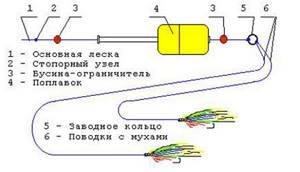
Scheme of equipment of imported bulldozer
About baits
Mostly flies are used. Sometimes they hang spoons or silicone fish. Not all flies are suitable as bait, or rather, any of them is not always suitable. It depends on the speed of the current of a particular river. Grayling has excellent eyesight and will not grab a hook that is lightly wrapped in lint at low speed.
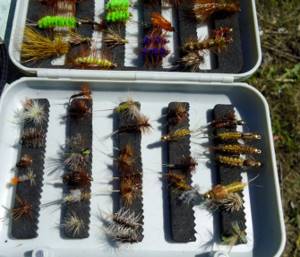
Flies that are as close as possible to the appearance of real insects
Graylings are far from stupid fish; this species is considered one of the most capricious. When fishing in slow currents, you need to use flies that are as similar as possible to real insects.
Fishing on fast rivers is much easier when it comes to choosing bait. Here you can safely put on a “coarser” fly, since the grayling will not have time to see it and will grab it. Siberians make them from cambric and wool.
Fishing technique and tactics
The choice of bombard type and bait placement technique depends on the strength of the current in a particular body of water. If fishing takes place on a lake, then the usual fan casting of bait is used. If we are fishing on a river, we must first of all focus on the strength of the flow.
Fishing is easiest on a lake or similar body of water. The choice of a specific bombard depends on the grayling sites at a particular time of year.
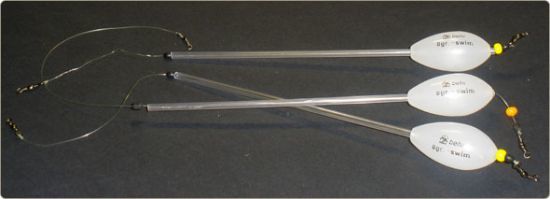
In summer, when insects are active, use a dry fly or a popper with a floating bombard. To catch grayling in the fall, when the fish go deeper, neutral and then sinking models are used.
Slow current
The slow current allows for a variety of casts, almost like on a lake. But still, the best animation technique occurs when casting the fly downstream. First, we float the bait down as far as fishing conditions allow.
Then we begin to slowly pull it towards us, accompanying the rotation of the reel with small twitches of the rod tip. A bite can occur both on the raft and on the animation towards you, so you need to be careful. The choice of bombard type also depends on the grayling sites.
Middle current
When fishing in a medium stream, after casting the bait will tend to move away from the angler downstream. Therefore, here they use wiring without jerking animation, holding the fly or wobbler with a fishing rod in a given fishing horizon.
Casting bait in the middle current is done perpendicular to it or slightly higher, at an angle of up to 45 degrees. Bombards are used mainly floating, even the current tends to drive them under the surface.
Fast current
Casting is done against the current, and fishing is carried out by drift. Sometimes, in these conditions, an installation with a final position of the float is used, and the baits are attached to the branches in front of it. When retrieving the bait, control it so that there is constant contact with it, otherwise in a stormy stream you may miss the bite.
When and how to catch
Grayling fishing begins from the time when a huge number of all kinds of insects fly out. Fish impatiently wait for the occasional fall of flies, beetles and other winged creatures in order to safely eat them. They also do not disdain larvae floating from the bottom. If the weather is clear, then grayling will bite only in the evening or early morning. On cloudy days, fish are active all the time.
First, the fisherman needs to find out where the small school of grayling is concentrated. They usually like to stand under swarms of flying insects - there is a high probability of falling into the water. Then you need to throw the bulldozer and you need to do this as carefully as possible.

The Siberian bamboo is so heavy that when it hits the water, a loud noise will be heard, frightening the fish.
A strong impact of the float on the water can scare away the target inhabitants! The fisherman needs to get used to the quiet casting of the bombard.
Grayling can bite both stationary and moving bait. Don't move the rod too fast - it looks unnatural and you won't fool the fish. The bombard should not give itself away either: the more it resembles something natural (a piece of bark, a stick), the better.
There are three ways to throw a bulldozer with a fly:
- against the flow of the river. Important nuance! The fisherman needs to reel the line towards himself so that the float moves a little faster than the river;
- with the flow. The fisherman casts the bait down the river, and then slowly winds the reel towards himself;
- across. There is also an important detail here: the fishing line must always be taut. The fly will look natural, attracting the attention of graylings.
You cannot cast without braking the boom just above the surface of the reservoir. If the fisherman does everything correctly, the float will not slap the water, and the likelihood of the line and flies intersecting will be reduced to zero.
Bombard for grayling
Bombarding for grayling is an alternative to fly fishing, allowing you to fish with dry and wet flies, as well as other light baits, with a simple spinning or feeder rod. Long casting helps to make the same float - bombard or sbirulino. In general, the tackle consists of the following elements:
- Rod. Here they use a long spinning rod of 2.7-3 meters, a medium feeder and even, in some cases, a four-meter lap dog. The bait test form must correspond to the weight of the bombard together with the rest of the load: fittings and bait.
- Coil. An inertia-free spool with a spool capable of holding 100-150 meters of fishing line. A high-quality friction clutch is the main condition for choosing a “meat grinder”.
- Fishing line. Since fishing is done at a long distance, the best option would be to use thin braid in combination with a shock leader, a piece of monofilament more than two rods long. The leader will allow you to throw heavier bombards, resist abrasion in strong places, and take on the load during forced fishing. In addition, it is easier to install equipment on nylon than on wicker.
- Bombard. A special float with an antenna and body, most often transparent. Depending on the fishing conditions, choose a sinking, neutral or floating sbirulino model.
- Accessories. Mandatory elements in the construction of gear are swivels and dampers - soft silicone stoppers.
- Leash. Made from thin braid or monofilament, depending on the fishing conditions, its length ranges from 50 centimeters to one and a half meters.
- Bait. Artificial bait or natural bait on a single hook.
The gear is assembled in the following sequence:
- A reel is placed on the selected fishing rod and equipped with the main fishing line - a braid of 0.10-0.14 millimeters.
- A shock leader - a monofilament with a diameter of 0.2-0.25 millimeters - is attached to the braid with a double sliding knot.
- A silicone stopper is mounted on the leader.
- Then the line is threaded through the bombard, so that the antenna is at the top, closer to the rod.
- After the sbirulino, a second stopper is placed to protect the swivel attachment point.
- A swivel is attached.
- A leash with bait is attached.
It just so happens that finding information about the method of fishing with a bombard is quite simple - this can be done on the Internet or in fishing periodicals, but it is much more difficult to find an angler who uses this method in practice. In any case, I have never met such fishermen on any of the reservoirs of the Moscow region, nor on the reservoirs of other adjacent regions.
My acquaintance with the bombarda happened a long time ago. Once I went to catch perch in one of the many quarries in the Tula region. According to a local resident, the depth in some places was more than five meters.
That day the perch was clearly not in the mood and was occasionally tempted by a small twister on a lead. However, I noticed that quite often the perch bites occur a few seconds after the bait splashes down, which indicates that the perch is at half-water.
Wiring in the thickness gave results, but the conclusion suggested itself - in this situation the turntable would be irreplaceable.
However, it was not possible to get the light spinner to the perch, and the large perch ignored it. The idea was already ripening in my head, and a couple of weeks later I stood on the bank of the quarry with new equipment: a slowly sinking bombard and a zero spinner on a one and a half meter leash.
Half an hour of searching for the required wiring horizon - and the result was not long in coming. When I was photographing my catch, a local fisherman came up to me and told me that so many perches are usually caught here in a whole day, and it was only eleven in the morning.
I said that perch is still being caught well, and when asked a reasonable question why I decided to stop fishing, I answered that in everything you need to know when to stop. He obviously liked my answer, and we started talking.
My new acquaintance, as expected, heard about the bombard for the first time, and I hope that after our conversation his fishing horizons expanded a little.
The next day, my friend and I set out on a long-awaited three-day chub trip. We arrived at the river around noon. The weather was clear and hot. Having quenched our thirst at a spring with ice-cold water, we began to unpack our gear.
To be honest, I completely forgot about the bombard then, as I was in a hurry to try out the newly purchased wobblers in the field. The chub was biting regularly that day. A friend was using tried-and-true crankbaits like Jackal Chubby and Smith Camion.
I decided to “rest” on Red Rag with SR and SSR depths. I’ll say right away that both models from Pontoon21 showed their best side, but I liked the wobbler in the SSR version a little more because of the spectacular bites.
They looked especially beautiful at sunset, when splashes suddenly appeared on the reddened surface of the water from a powerful attack of a chub.
At night we abandoned fishing, despite the fact that we had originally planned it: our fishing thirst was quenched, we were not interested in fish as a food item, since we fished on a catch-and-release basis, and decided to rest until dawn in order to meet a new day with fresh strength.
However, the morning tempered our fighting ardor. The weather had deteriorated greatly: a fairly decent wind was blowing, driving a good wave along the river, and on these waves scraps of algae and leaves torn off by the wind swayed. Fishing with wobblers with small depths did not bring success. We decided that the chub had gone to depth, and began to methodically “fire” the water area with dips.
We suggest you familiarize yourself with: Tube spinner for pike
In local areas, we periodically caught several perch in a row, but today it was not the desired object of our hunt, and therefore my fishing buddy began to talk about an unplanned return home. Maybe we would have left soon, but on one of the trips with a deep-sea wobbler, some fish attacked the “whiskers” from the fishing line cutting the water surface. After a few casts the situation repeated itself.
Later, when analyzing the success of the fishing that actually took place, I realized that the chub that day, despite the cold weather and wind, was not going to depth - it stood under the overhanging bushes, waiting for insects falling from the branches.
Of course, the chub loves to feed in such places even in calm weather, but apparently in the wind, obeying instinct, the fish reached the greatest concentration there. But these are conclusions after the fact. That same morning, having seen the attacks of the “whiskers,” I involuntarily remembered the bombard and the flies given to me the day before.
Actually, there was nothing to lose: the chub didn’t want to bite, and perch could be caught much closer to home, and this turned out to be just the case when it was possible to experiment. I mounted a classic rig with a bombard.
I put a bombard on the main line, tied a triple swivel, then a one and a half meter leash, and to it an olive-colored palmer (caterpillar), which a friend recommended to me as the number one bait for chub.
On the very first retrieve, I felt a slight hook, then immediately a second one, and at first I decided that the fly tied on the double was clinging to the algae floating along the river. However, after reeling out the tackle, I discovered that there was no grass on the hooks. Hope began to glimmer.
On one of the wires, my hand felt a slight “knock”, and I instantly reacted. At the other end a chub squashed and a floating bombard danced on the waves.
My friend, observing this picture, firmly decided to buy a dozen different bombards and a “bag of assorted flies” before the next trip, after which, without a sip, he went to prepare dinner, on the condition that I would let him catch a bombard for it. Of course, I didn’t mind, and that day my friend caught his first chub on an artificial fly...
On one of the fishing resources on the Internet, a dispute once broke out about what type of fishing the bombard should be classified as: a spinning rod, a fly fishing rod, or a float rod? In my opinion, this is definitely not a fishing rod, because the latter still does not involve the use of artificial baits, and certainly not fly fishing, because in fly fishing, specialized rods and reels are necessary, not to mention cords and leader lines, plus you can add virtuoso casting skills.
My opinion can be disputed, but fishing with a bombard is closest to spinning fishing, in which, as you know, a sinker is often used to deliver one or another artificial bait to the desired distance.
Well, even if the sinker in our fishing is quite peculiar, but, in essence, this does not change anything. And since the bombard is closest to the spinning rod, then a regular spinning rod is suitable for fishing with this equipment.
On small and medium-sized rivers, the best spinning rods will be 2.7–3 m long, of course with a test corresponding to the weights of the bombards being thrown.
However, it is worth noting that the bombarda loads the blank only during casting, and during the retrieving process, thanks to its streamlined shapes, it creates virtually no resistance, so if the weight of the bombarda is close to the values of the upper test of the rod, then there is nothing to worry about.
There was a case when I made a mistake with the estimated width of the river in an unfamiliar place, and I had to throw a twenty-gram bombard with a spinning rod with a test of 3-15 grams. Of course, it’s better not to do this and have balanced tackle, but it’s worth noting that the spinning rod is still safe and sound.
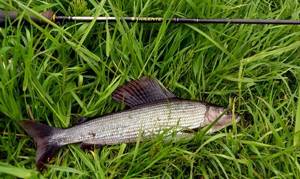
For fishing in large areas, you will need a longer rod.
It is advisable, but not at all necessary, to purchase specialized tackle: you can get by with a fly rod or even a feeder rod with a length of at least 3.3 m, although this also has its own nuances: if the banks of the reservoir are heavily overgrown, then it will be difficult to cast with a long rod, since its implementation requires a sufficient amount of free space.
